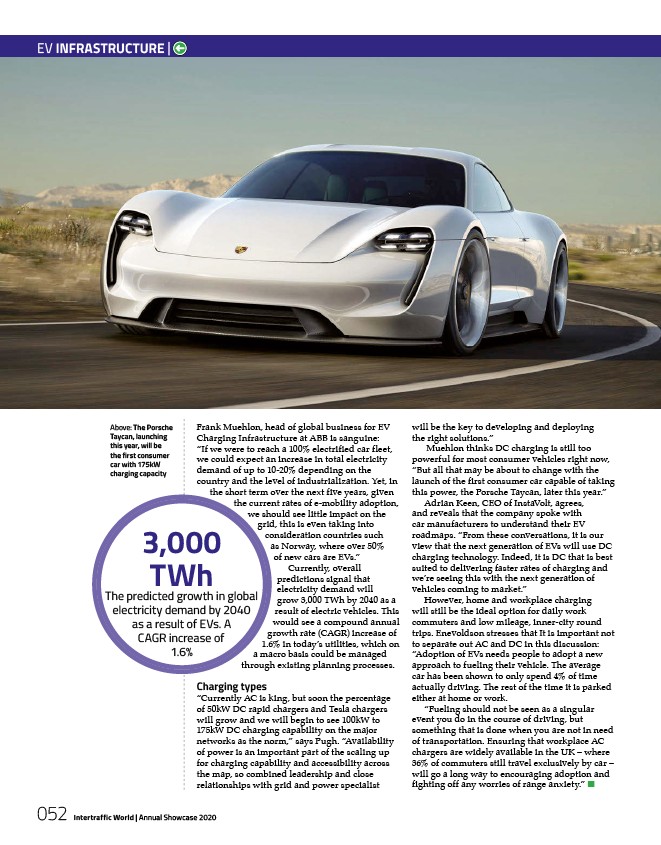
EV INFRASTRUCTURE |
Frank Muehlon, head of global business for EV
Charging Infrastructure at ABB is sanguine:
“If we were to reach a 100% electrified car fleet,
we could expect an increase in total electricity
demand of up to 10-20% depending on the
country and the level of industrialization. Yet, in
the short term over the next five years, given
052 Intertraffic World | Annual Showcase 2020
the current rates of e-mobility adoption,
we should see little impact on the
grid, this is even taking into
consideration countries such
as Norway, where over 50%
of new cars are EVs.”
Currently, overall
predictions signal that
electricity demand will
grow 3,000 TWh by 2040 as a
result of electric vehicles. This
would see a compound annual
growth rate (CAGR) increase of
1.6% in today’s utilities, which on
a macro basis could be managed
through existing planning processes.
Charging types
“Currently AC is king, but soon the percentage
of 50kW DC rapid chargers and Tesla chargers
will grow and we will begin to see 100kW to
175kW DC charging capability on the major
networks as the norm,” says Pugh. “Availability
of power is an important part of the scaling up
for charging capability and accessibility across
the map, so combined leadership and close
relationships with grid and power specialist
will be the key to developing and deploying
the right solutions.”
Muehlon thinks DC charging is still too
powerful for most consumer vehicles right now,
“But all that may be about to change with the
launch of the first consumer car capable of taking
this power, the Porsche Taycan, later this year.”
Adrian Keen, CEO of InstaVolt, agrees,
and reveals that the company spoke with
car manufacturers to understand their EV
roadmaps. “From these conversations, it is our
view that the next generation of EVs will use DC
charging technology. Indeed, it is DC that is best
suited to delivering faster rates of charging and
we’re seeing this with the next generation of
vehicles coming to market.”
However, home and workplace charging
will still be the ideal option for daily work
commuters and low mileage, inner-city round
trips. Enevoldson stresses that It is important not
to separate out AC and DC in this discussion:
“Adoption of EVs needs people to adopt a new
approach to fueling their vehicle. The average
car has been shown to only spend 4% of time
actually driving. The rest of the time it is parked
either at home or work.
“Fueling should not be seen as a singular
event you do in the course of driving, but
something that is done when you are not in need
of transportation. Ensuring that workplace AC
chargers are widely available in the UK – where
36% of commuters still travel exclusively by car –
will go a long way to encouraging adoption and
fighting off any worries of range anxiety.” ■
Above: The Porsche
Taycan, launching
this year, will be
the first consumer
car with 175kW
charging capacity
3,000
TWh The predicted growth in global
electricity demand by 2040
as a result of EVs. A
CAGR increase of
1.6%